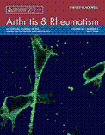Cadherin 11 promotes invasive behavior of fibroblast-like synoviocytes
Dr. Lee has received consulting fees, speaking fees, and/or honoraria from Biogen Idec, UCB Pharma, Resolvyx, Novartis, and Johnson & Johnson (less than $10,000 each) and from Synovex (more than $10,000) and owns stock or stock options in Resolvyx and Synovex.
Drs. Lee and Brenner are coinventors on patents for the use of cadherin 11 in arthritis that have been licensed by Synovex.
Dr. Brenner has received consulting fees, speaking fees, and/or honoraria from Synovex (more than $10,000) and owns stock or stock options in Synovex.
Abstract
Objective
To define the expression pattern of cadherin 11 in the destructive pannus tissue of patients with rheumatoid arthritis, and to determine whether cadherin 11 expression in fibroblast-like synoviocytes controls their invasive capacity.
Methods
Cadherin 11 expression in rheumatoid synovial tissue was evaluated using immunohistochemistry. To examine the role of cadherin 11 in regulating the invasive behavior of fibroblast-like synoviocytes, we generated L cell clones expressing wild-type cadherin 11, mutant cadherin 11, and empty vector–transfected controls. The invasive capacity of L cell transfectants and cultured fibroblast-like synoviocytes treated with a blocking cadherin 11–Fc fusion protein or control immunoglobulin was determined in Matrigel invasion assays.
Results
Immunohistochemical analysis revealed that cadherin 11 is abundantly expressed in cells at the cartilage–pannus junction in rheumatoid synovitis. Assays to determine invasion demonstrated a 2-fold increased invasive capacity of cadherin 11–transfected L cells compared with L cells transfected with E-cadherin or control vector. The invasive behavior of L cells stably transfected with a cadherin 11 construct that lacked the juxtamembrane cytoplasmic domain was diminished to the level of vector control L cells. Furthermore, treatment with the cadherin 11–Fc fusion protein diminished the invasive capacity of fibroblast-like synoviocytes.
Conclusion
The results of these in vitro studies implicate a role for cadherin 11 in promoting cell invasion and contribute insight into the invasive nature of fibroblast-like synoviocytes in chronic synovitis and rheumatoid arthritis.




